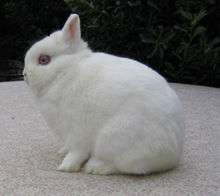Polish rabbit

The Polish Rabbit is a dwarf breed of domestic rabbit, most often bred by fanciers and commonly exhibited in rabbit shows. Despite its name, it originated in England, not Poland.
Appearance
Today, the American Polish rabbit is used as a fancy exhibition breed and pets. They are small rabbits with short ears that touch each other all the way to the tips. They should have a short head with full cheeks and bold eyes. Due to their small size, the Polish rabbit is often confused with the Netherland dwarf, although the Polish is a little larger and the head is not rounded. There are many other differences between the two breeds, such as coat structure, body type and colors. The accepted weights of the American Polish rabbit 6 months or older are 2½ to 3½ pounds. The ideal weight is 2½ pounds.[1]
Until the 1950s, most American Polish rabbits were white with either red eyes or blue eyes. The ruby-eyed white is a true albino. The blue-eyed white has the Vienna white gene and is not a true albino. Since the 1950s, colored Polish breeds have been recognized by rabbit clubs. In 1957, the American Rabbit Breeders' Association approved the black and chocolate Polish. In 1982, the blue variety was approved and in 1998 the broken variety was allowed.
In the UK, the American Polish is unknown. Polish rabbits in Britain are the breed known as Britannia Petite in the USA.
Personality and care
Due to their small size, Polish rabbits need less space in cage and barn facilities and take up less space in apartments than some of the larger breeds. Cage bottoms should not be slippery, as this can cause hip injuries and splay leg.
The American Polish rabbit is generally calm and friendly, especially the bucks. Does can be territorial if not spayed. Children should always be supervised when handling rabbits, to ensure that the rabbit is not inadvertently injured.
Rabbits can be easily trained to use a litter box and to accept a harness with leash when out of their cage. Rabbit-proofing a room where a rabbit is roaming freely is critical. Rabbits will chew on carpets, baseboard and especially electrical cords.
Feeding
Polish rabbits should be fed about 1/4-1/2 cup of pelleted feed every day depending on the activity level of the rabbit.
It is vital that rabbits have access to unlimited fresh hay or grass to ensure good dental health, gastrointestinal health, urinary tract health, weight control and for environmental enrichment. [2]
Treats such as fruit and carrot should be fed sparingly; typically a portion no larger than the tip of the thumb. Fresh young dandelion leaves, parsley and spinach are nutritious choices for treats. Vegetables in the cabbage family and high-sugar foods such as corn should be avoided, as these can cause gastroenteritis.
A healthy rabbit should be well fleshed but not flabby. This is tested by running one's hand over the rabbits back. A firm layer of flesh over the ribs and spine together with the ribs and spine should be felt, indicating proper nutrition. A prominent spine indicates under nutrition and is corrected by increasing the feed. Inability to feel the spine indicates over nutrition and likewise, the amount of feed is decreased.
Health concerns
As with other rabbits, Polish rabbits do not do well in high temperatures, but can withstand low temperatures if they are kept dry and out of drafts. They are prone to hairball obstructions and matted coats if not cared for properly. Other health concerns include ear mites, Pastureland, respiratory disease, dental problems, urinary bladder stones and fractured backs. Be quick to notice any changes in diet or litter box habits and contact a rabbit veterinarian immediately.
The average life span of a breeding Polish rabbit is 5 to 6 years.[3]
See also
References
External links
- American Rabbit Breeder's Association
- American Polish Rabbit club
- Polish Rabbit Breed History
- Breeds of Rabbits Chart